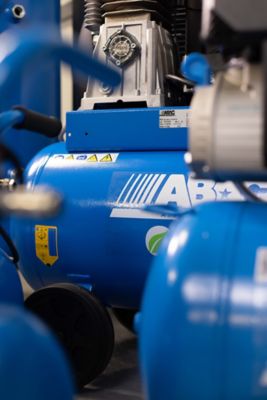Why Selecting the Appropriate Air Compressor Size is Important
Selecting the appropriate air compressor size is essential for several reasons. Firstly, it ensures that your compressor can handle the demands of your tools and applications, leading to efficient and effective operation.
Secondly, the right size impacts the performance, reliability and suitability of the compressor for specific tasks. An undersized compressor may struggle to meet the demands, leading to frequent downtime and potential damage, while an oversized compressor can be unnecessarily costly and inefficient.
Factors to Consider When Selecting an Air Compressor Size
Airflow (CFM)
Airflow, measured in cubic feet per minute (CFM), is a critical factor when selecting an air compressor. It indicates the volume of air the compressor can deliver per minute. Different tools and applications have specific CFM requirements, and it's essential to ensure that your compressor can meet these demands. For instance, spray painting typically requires a compressor with 4-8 CFM at 30-50 PSI.
Pressure (PSI and BAR)
Pressure, measured in pounds per square inch (PSI) or bars (BAR), refers to the amount of force needed to perform a certain amount of work. The required PSI or BAR depends on the tool or application being used. For home use, the PSI requirements are typically lower, but industrial applications may require higher PSI or BAR levels.
Free Air Delivery (FAD) and Flow Rate (l/min)
Free Air Delivery (FAD), measured in liters per minute (l/min), is another crucial metric. It indicates the actual volume of air delivered by the compressor under specific conditions. Understanding both FAD and flow rate is essential for ensuring that the compressor can handle the demands of tools and applications. Rotary screw air compressors, for instance, provide more flow per kW or HP than piston compressors, making them suitable for high-demand applications.
Specific Application Requirements
Different applications have unique requirements that influence the size of the air compressor needed. For example, a construction crew may need a large, high-pressure air compressor, while a hobbyist may only require a small, portable unit. Understanding the specific needs of your application is crucial in selecting the right compressor size.
Understanding Capacity and Flow Rate
Capacity and flow rate are two critical metrics in air compressor sizing. Capacity refers to the storage ability of the compressor, while flow rate indicates the amount of air the compressor can deliver per minute. Both metrics are essential for ensuring that the compressor can handle the demands of tools and applications. Rotary screw air compressors, for instance, provide more flow per kW or HP than piston compressors, making them suitable for high-demand applications.
Determining CFM and PSI Requirements
To determine the CFM and PSI requirements for your application, you need to evaluate all the tools used at once and increase their total CFM ratings by 30% to account for factors such as leaks or added tools. A volume conversion calculator can assist in accurately sizing an air compressor. For example, if you have multiple tools with varying CFM requirements, add up their CFM ratings and then add an additional 30% to ensure your compressor can handle the load.
Types of Air Compressors
Rotary Screw Air Compressors
Known for their efficiency and ability to provide a continuous flow of air, they are ideal for industrial applications that require a high volume of air. These compressors are more efficient than piston compressors and provide more flow per kW or HP.
Piston Air Compressors
Also known as reciprocating compressors, they are commonly used for smaller applications. They are less expensive than rotary screw compressors but may not be suitable for high-demand applications due to their lower flow rate and efficiency.
Tank Size and Duty Cycle
The tank size of an air compressor affects its ability to deliver sustained air pressure - a larger tank size delivers higher levels of air pressure for extended periods, minimizing downtime. The duty cycle refers to the ratio of time between air delivery and air refill. Applications requiring bursts of air can tolerate a smaller duty cycle, but those needing constant air pressure require a 100% duty cycle.
Safety Considerations
Unsafe usage of air compressors can lead to injury and equipment damage. The main risks include hearing damage, potential explosion due to overheating, and dislodged particles that can harm crew members. It's essential to follow safety guidelines and use the right size air compressor to mitigate these risks.
Common Questions
What factors affect an air compressor's performance?
Several factors affect an air compressor's performance, including size, air pressure, air delivery, and overall design. The power supply, air capacity, and tank size also play a role in determining performance.
How to select the right size air compressor?
To select the right size air compressor, consider the size of the application, the maximum required operating pressure, the required CFM, horsepower, tank size, and duty cycle. Evaluate all the tools used at once and increase their total CFM ratings by 30% to account for leaks or added tools.
What is the average CFM rating for some of the most common air-powered tools, and why is it important to consider?
The average CFM rating for common air-powered tools varies. For example, spray painting requires 4-8 CFM at 30-50 PSI, while a nail gun may only need 2-4 CFM at 70-90 PSI. It's important to consider these ratings to ensure your compressor can meet the demands of your tools.
What main risks do unsafe air compressor usages pose, and how can people prevent them?
The main risks include hearing damage, potential explosion due to overheating, and dislodged particles that can harm crew members. These risks can be prevented by following safety guidelines, using the right size air compressor, and ensuring proper maintenance.












